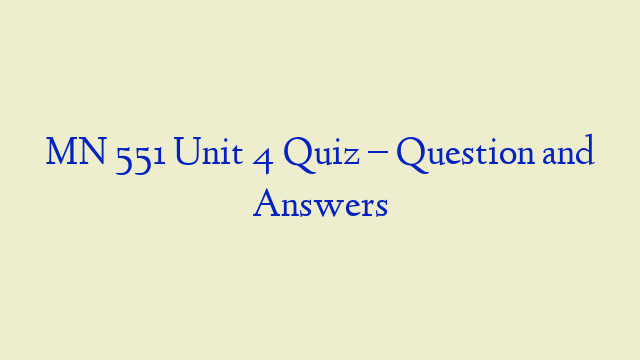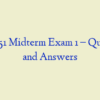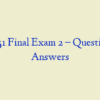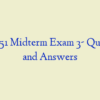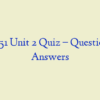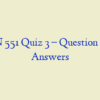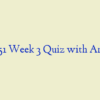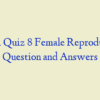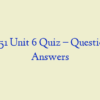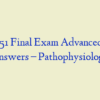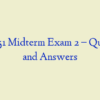Description
MN 551 Unit 4 Quiz – Question and Answers
- Which of the following patients who presented to a walk-in medical clinic is most likely to be diagnosed with a rhinosinusitis rather than a common cold?
- A 44-year-old woman developed calf pain during a transatlantic flight followed by acute shortness of breath upon arrival at her destination. She was subsequently diagnosed with a pulmonary embolism (PE), which resolved with anticoagulant therapy. Which of these statements best characterizes the underlying problem of her PE?
- A premature infant on mechanical ventilation has developed bronchopulmonary dysplasia (BPD) and is showing signs and symptoms of hypoxemia, low lung compliance, and respiratory distress syndrome (RDS). Which of the following is the most likely contributor to the infant’s present health problem?
- Which of the following residents of a long-term care facility is most likely to be exhibiting the signs and symptoms of chronic obstructive pulmonary disease (COPD)?
- A 66-year-old male presents to the emergency department accompanied by his wife who claims that he has been acting confused. The man is complaining of a sudden onset of severe weakness and malaise and has a dry cough and diarrhea. His temperature is 102.8°F and his blood work indicates his sodium level is 126 mEq/L (normal is 135 to 145 mEq/L). What will be the assessing nurse practitioner’s most likely suspicion?
- A 51-year-old female patient who is 2 days postoperative on a surgical unit of a hospital is at risk for developing atelectasis as a result ofbeing largely immobile. Which of the following teaching points by her nurse practitioner is most appropriate?
- Due to complications, a male postoperative patient has been unable to mobilize for several days following surgery and has developed atelectasis. Which of the following processes would his care team anticipate with relation to his health problem?
- Which of the following clinical findings would be most closely associated with a patient who has interstitial lung disease rather than COPD?
- A male lifetime smoker has died as a result of chronic obstructive pulmonary disease. Which of the following phenomena regarding his alveoli would his care team have most reasonably expected in the weeks prior to his death?
- A 21-year-old male patient has suffered a head injury. During a crash on his motorcycle, and a deficit that assessments have revealed is an impaired swallowing mechanism. He has also developed aspiration pneumonia. Which of the following statements most accurately capture an aspect of his condition?
- A short, nonsmoking middle-aged man presents to the emergency department with left-sided chest pain and a cough. He says that the pain started abruptly, just after lunch, and that breathing and coughing make it worse. He_denies recent injury. He is breathing shallowly and rapidly and expresses fear that he may be having a heart attack. Breath sounds are normal, and he is not cyanotic. Which condition is most likely causing his symptoms?
- Which of the following statements best conveys an aspect of the respiratory pressures that govern ventilation?
- The mother of a 7-year-old boy who has recently been diagnosed with childhood asthma has come to the education center to learn more about her son’s condition. Which of the following teaching points is most justifiable?
- Which of the following phenomena is most likely occurring during a child’s alveolar stage of lung development? mn 551 unit 4 quiz
- A 71-year-old woman is dependent on oxygen therapy and bronchodilators due to her diagnosis of emphysema. Which of the following processes would her care team be most justified in ruling out?
- A patient who presented with shortness of breath and difficulty climbing stairs has been diagnosed with pulmonary fibrosis, a disease characterized by scarring of the alveoli. What would her care team anticipate when observing her breathing?
- Which of the following patients are NOT displaying known risk factors for the development of pulmonary emboli? mn 551 unit 4 quiz
- Following a winter power outage, a patient who had been using a home gasoline generator began to experience dizziness and headaches and was diagnose with carbon monoxide poisoning.
- What is the goal of hyperbaric oxygen treatment for carbon monoxide poisoning?
- A nurse practitioner is performing patient teaching about the influenza virus with each patient who has come to the clinic to receive that year’s vaccine. Which of the following statements by patients best reflects an accurate understanding of the flu virus?
- A 77-year-old lifetime smoker has been diagnose with a tumor in his lung at the site of an old tubercle scarring site, located in a peripheral area of his bronchiolar tissue. What is this patient’s most likely diagnosis?
- As a result of dehydration, a patient’s epithelial cells are producing insufficient amounts of mucus. Consequently, the patient’s mucociliary blanket is compromised. Which of the following changes would a care provider most reasonably anticipate as a direct result of this change?
- Which of the following statements best captures the etiology of the acute response phase of extrinsic (atopic) asthma? mn 551 unit 4 quiz
- A 62-year-old female smoker is distraught at her recent diagnosis of small cell lung cancer (SCLC). How can her nurse practitioner most appropriately respond to her?
- About 3 weeks after razing an old chicken house, a 71-year-old retired farmer has developed a fever, nausea, and vomiting. After ruling out more common health problems, his care provider eventually makes a diagnosis of histoplasmosis. Which of the following processes is most likely taking place?
- Which of the following situations would be most deserving of a pediatrician’s attention?
- A female patient is requiring supplementary oxygen by facemask due to her reduced lung compliance.
- As a consequence of long-standing lung disease, a patient is in a chronic state of hypoxia. Which of the following phenomena would the patient’s nurse practitioner be most justified in anticipating?
- A 3 yr old boy has developed croup following a winter cold. His nurse practitioner would recognize that which of the following causative microoganisms and treatments are most likely?
![]()
